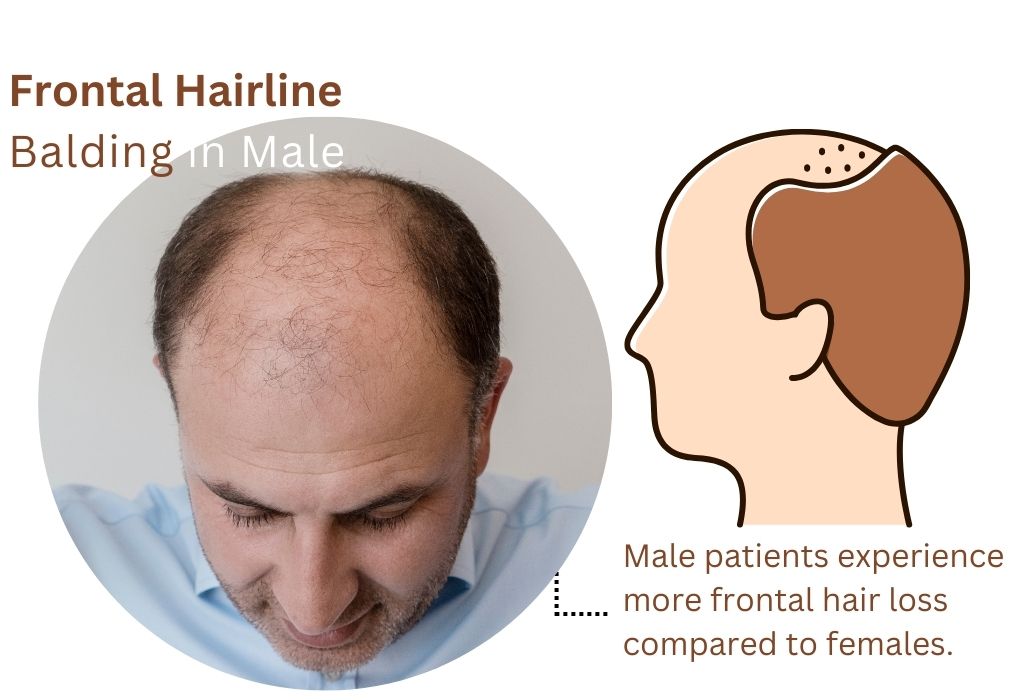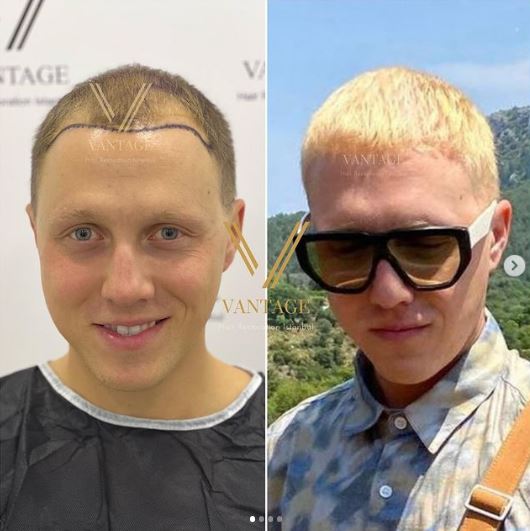
Frontal hair loss is a common problem and affects 1 in 10 men suffering from moderate to severe frontal baldness. If left untreated, it can become quite noticeable. As with all types of hair loss, it’s crucial to understand the underlying reasons before evaluating treatment options such as hair transplantation.
In the rest of this article, you’ll learn about:
- The reasons for frontal balding
- Its development cycle in male and female patients
- Treatment options
- The importance of Turkey in hair loss treatment
Frontal Hairline Balding in Male

Male patients experience more frontal hair loss compared to females. Typically, men have symptoms such as hair loss at the temples and circular hair loss on the top of the head.
The severity of frontal balding varies from patient to patient. A treatment plan is prepared by the surgeon based on their stage in the Norwood scale.
Here are the primary reasons behind frontal hair loss in men:
- Genetic factors: Family members with FFA
- Hormonal imbalances
- Alopecia areata
- Aging
- Smoking
- Nutritional deficiencies
- Stress and anxiety
- Pharmaceutical drugs
Men may adopt new hairstyles or turn to medical treatments for frontal balding. Minoxidil and Finasteride can to some extent stop hair loss and strengthen hair follicles. Men looking for a more permanent solution are exploring hair transplant options.
Frontal Hairline Balding in Female

Hair loss among men and women can have different etiologies. As usual, frontal hair loss in women is related with thinning of the hair structure on the entire scalp.
Here are the main reasons behind frontal hair loss in women:
Traction Alopecia:
- Occurs when hair is frequently pulled back tightly, leading to stress on the hair follicles. Common culprits include tight ponytails, braids, or buns.
- Continued stress on the follicles can result in permanent hair loss. Loosening hairstyles can halt the progression of thinning due to traction alopecia.
Frontal Fibrosing Alopecia (FFA):
- Once considered rare but now FFA is increasingly diagnosed in women worldwide.
- Typically occurring within two to 12 years after menopause, because of heavy loss of blood during menstrual periods. Often begins with eyebrow thinning and extends to the front hairline.
- Itching, pain and inflammation may accompany.
- Professionals think that the condition is triggered by immune system attacks on hair follicles, which are influenced by multiple factors including genetics, hormones and chronic inflammation.
- Some evidence suggests a correlation between FFA and autoimmune diseases like lupus or hypothyroidism.
Other Reasons:
- Diffuse hair loss across the scalp, though thinning may be more noticeable around the hairline.
- Potential factors include nutritional deficiencies, physical and emotional stress, and certain medical conditions.
- Diagnosis through physical examination and blood work is crucial to determine the underlying cause.
Frontal hairline Balding Causes
There are different forms of hair loss. Some people have patchy hair loss, which means severe hair loss in a particular area. Some people have severe hair loss in the front of the head (forehead area), which is called frontal fibrosing alopecia. There are also different characteristics of male-pattern baldness and female-pattern baldness. In men, advanced hair loss along the hairline is more common.
Among the causes of all these types of hair loss, these are on the top:
- Problems common to both men and women:
- Ageing
- Hereditary hair loss
- Stress
- Nutrient deficiencies
- Medication
- Conditions only observed in women:
- Menopause-related hair loss
- Female-pattern baldness
- Conditions only observed in men:
- Male-pattern baldness
Frontal Hairline Balding Solutions in Turkey
Turkey is a country known worldwide for its success in hair transplants. Why wouldn’t you prefer Turkey for the treatment of hair loss in the frontal region? You can consider evaluating the Follicular Unit Extraction (FUE) technique, which is the most commonly preferred option, especially by male patients. Within 6 months after the treatment, almost all patients experience noticeable hair growth. On average, a development of approximately 50-60% is observed. By the end of a year, most patients report 100% hair growth.
FUE hair loss treatment is a less invasive technique in which healthy hair follicles from the donor area are transplanted into the recipient area. There are both shaven and unshaven FUE methods. Would you like to decide together on the best treatment for your needs? Get in touch now and let’s start your hair transformation journey!
FAQ about Frontal Hairline Balding
Can frontal hair loss grow back?
You can stop hair loss with life changes, various medications and dietary changes, but hair transplantation is needed to regrow hair from that area.
Can you fix frontal baldness?
No, there is no cure for frontal baldness. However, you can control this issue with a combination of a group of therapies such as hair transplants, medications and lifestyle changes.
At what age does frontal fibrosing alopecia start?
It is not possible to give a precise age range. In some patients, hair loss starts in the 20s, while in others it starts at an older age. Hair loss accelerates after menopause in women. In men, it generally varies depending on stress and health status. Genetic factors also play a big role in this.
What’s the best haircut for frontal baldness?
Hairstyles that men can choose for receding hairline include caesar cut, buzz cut, crew cut, side part, faux hawk. Women may also consider giving up hair tying styles such as tight ponytails, braids, or buns.
Where can I get a hair transplant for frontal balding?
You can undergo this treatment at a clinic in a sterile and safe environment with a successful team. Vantage Clinic is one of the most prestigious hair transplant clinics located in Istanbul. It applies modern hair transplantation methods such as FUE and DHI. By planning the entire process including transportation, accommodation, and communication, it ensures you have a pleasant holiday and treatment experience.
Does an M shaped hairline mean balding?
M-shaped hairline, may be genetic. It does not mean a balding signal in every patient. However, in some patients an “M” or “V” shaped hairline is a sign of baldness.
Article Review By: Dr. Jyothi Shenoy V
Profile Link
MBBS, MD – Obstetrics & Gynaecology, MRCOG(UK)
23 Years Experience Overall







